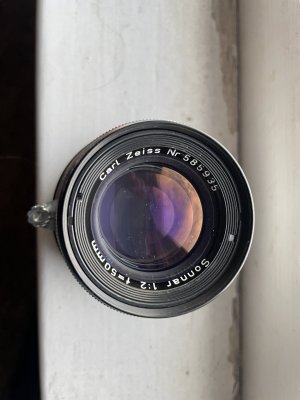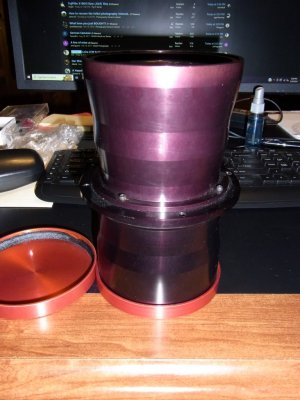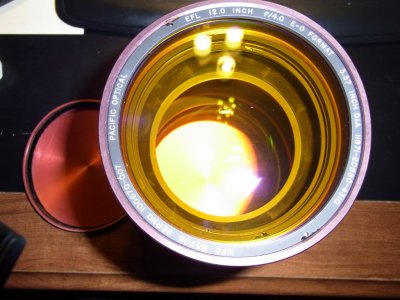dexdog
Mentor
I agree that this lens has an improved mount, reminds me of the much later Canon FD mount.
- The 25mm (not labelled in cm, oddly) Topogon is another scarce but thoroughly excellent post-war Jena lens. Zero distortion, great sharpness across the entire frame at one stop down and a very novel take on the Contax bayonet mount I wish some other lenses had implemented. It's much quicker to (un)do.
milescl
Well-known
Who here has collected and documented early examples of f1.5 and f2 Sonnars from post-war production in Oberkochen? I haven't paid enough attention to them, either as a user or collector, but have never seen examples below, say, #60,xxx.
JakobN
JakobN
Thank you for the clarification.My optical engineer used the term "Prescription of the lens" for the exact design, radius, curvature, index of refraction, thickness, and spacing of elements for a lens. "Formula"- was more like a block diagram.
A "0.15mm" difference in length is bigger than what I would expect for manufacturing deviation. The shims used in these lenses go down to 0.01mm.
Räuber
Established
Mr. Thiele offers a Fabrikationsbuch III that contains the Zeiss Oberkochen production. It shows that the Sonnar 50mm f/1,5 started at serial 46k and Sonnar 50mm F/2 at serial 581k.Who here has collected and documented early examples of f1.5 and f2 Sonnars from post-war production in Oberkochen? I haven't paid enough attention to them, either as a user or collector, but have never seen examples below, say, #60,xxx.
ZO Sonnar 50mm F/1,5 48k

Zeiss-Opton 50mm f1.5 Sonnar T Lens Contax Rangefinder #031 | eBay
Local Pickup. We want you to receive the item as quickly as possible! Intentional or accidental abuse or neglect. This warranty does not cover original condition. Very rough looking.
www.ebay.de
ZO Sonnar 50mm F/2 582k

Contax Zeiss-Opton Nr 582616 Sonnar 1:2 f-50mm | eBay
Zeiss-Ikon Contax Nr 582616 Sonnar 1:2 f-50mm. Antique from the 30s!
www.ebay.com
milescl
Well-known
This examples a lot for me, thank you.Mr. Thiele offers a Fabrikationsbuch III that contains the Zeiss Oberkochen production. It shows that the Sonnar 50mm f/1,5 started at serial 46k and Sonnar 50mm F/2 at serial 581k.
ZO Sonnar 50mm F/1,5 48k

Zeiss-Opton 50mm f1.5 Sonnar T Lens Contax Rangefinder #031 | eBay
Local Pickup. We want you to receive the item as quickly as possible! Intentional or accidental abuse or neglect. This warranty does not cover original condition. Very rough looking.www.ebay.de
ZO Sonnar 50mm F/2 582k

Contax Zeiss-Opton Nr 582616 Sonnar 1:2 f-50mm | eBay
Zeiss-Ikon Contax Nr 582616 Sonnar 1:2 f-50mm. Antique from the 30s!www.ebay.com
On that note it seems I have a “collector’s delight” to share:
Here’s an early (if you’d be willing to share the Thiele data on this one, I’d very much appreciate it) Carl Zeiss Sonnar 50mm f2 #585,935. Serial number would suggest that it should be labeled “Opton” with the red T, but it lacks both. Seems the curiosities continued on in Oberkochen…

Räuber
Established
You are right. The serial of your lens belongs to a very early Zeiss-Opton lens but the body and name ring is that of the last Zeiss version of Carl Zeiss 50mm F/1,5. I call such lenses out-of-time Sonnar lenses as it seems that they traveled through time. How did Zeiss do this? How does they know in 1950 how to build a Sonnar from 1958? The answer is not so mystical. Probably the original lens needed a repair. But instead of a repair CZ replaced the old lens with a new one from the current (later) production. For this they took a fresh 1958 Sonnar and engraved the lens ring with the old serial.This examples a lot for me, thank you.
On that note it seems I have a “collector’s delight” to share:
Here’s an early (if you’d be willing to share the Thiele data on this one, I’d very much appreciate it) Carl Zeiss Sonnar 50mm f2 #585,935. Serial number would suggest that it should be labeled “Opton” with the red T, but it lacks both. Seems the curiosities continued on in Oberkochen…
View attachment 4833692
milescl
Well-known
Well there goes my time-traveler theory!You are right. The serial of your lens belongs to a very early Zeiss-Opton lens but the body and name ring is that of the last Zeiss version of Carl Zeiss 50mm F/1,5. I call such lenses out-of-time Sonnar lenses as it seems that they traveled through time. How did Zeiss do this? How does they know in 1950 how to build a Sonnar from 1958? The answer is not so mystical. Probably the original lens needed a repair. But instead of a repair CZ replaced the old lens with a new one from the current (later) production. For this they took a fresh 1958 Sonnar and engraved the lens ring with the old serial.
DownUnder
Nikon Nomad
For me rarity has always taken second place to affordable.
I've had some odd-bod cameras in my time but my collection, now reduced to about 15 from a 'high' of 60+ when I retired in 2012 and decided to sell off as many as I could to clear the house and keep my marriage intact, I would rate as entirely "what I could afford".
Overlooking my four Rolleiflex/Rolleicord TLRs which are wonderful machines but not all that rare, my most unusual (again a personal opinion) camera is my Leica iif, bought at an estate sale a few years ago, not cheap but at a reasonable price. I've added a few lenses and other Leitz bits and pieces as they came my way and I now have an enjoyable kit, one I can easily take with me out in the field without bursting the bottom of my backpack.
I've owned more than a dozen Rollei TLRs in my time, including a Tele and a Wide Angle model, both sold off at a time when they didn't fetch as good prices as they do now, and which I had kept. Again, not ultra rarities but seldom seen nowadays.
Of these Rolleis, my favorite 'shooter' is a Rolleicord Vb in user condition but mechanically functional, bought as a kit with a big box of bits and pieces, again from a deceased estate, for $95. I use it with a 16 exposure kit. The Zeiss Xenar lens on it produces amazingly good images.
Next on my list are two German folders, a Zeiss Nettar from ca 1950 and a VOigtlander Perkeo I. Again, not quite one of a kind cameras, but enjoyable to use and they fit into a coat pocket with a Weston Master, V one or two filters, a lens hood and some 120 film.
Another camera I seldom see out and about today is the Contax G1. At one time I had four of these but over the years I've disposed of three. Now have only one which has a somewhat unreliable rewind (at times it works and now and then it doesn't, so out with the black change bag (aka the darkroom T-shirt) and a bit of tugging to get the damn film out without ripping it. Last year I sent all my Contax Z lenses to consignment sale, the 45/2.0 went in a flash but the 21, 28, 35 and 90 all gathered dust on the shop shelves so I'm leaving them to my stepkids as part of my estate when I pop off. I use them now and then, my favorite is the 28/2.8 Biogon and the quality of the negatives (who can afford slide film or E6 processing these days?) never cease to impress.
The Contax G lenses, while made in Japan, are nothing short of superb, if with an unfortunately obscure mount which renders them useless for other cameras unless one invests in an expensive mount rebuild. I wonder if these will ever be collectables.
I envy those who luck into fantastically obscure cameras, especially so when these are still in working order. One friend found an original 1880s Kodak box camera in almost mint condition and still in its original case with all the bits and pieces included and even the original manual, on a shelf in a charity shop in Melbourne, bought it for a very reasonable price and did such a good deal on resale to a Japanese collector that he paid for most of a new Leica M6 with the proceeds. Lucky him, this has never happened to me.
My camera collecting days are now past but I still enjoy visiting charity shops in country towns to see what I can find in boxes or on back shelves. Alas, nothing much turns up. Two recent 'spots' were a Nikkor 300 F-mount from the '60s in okay condition which the shop wanted $120 for - my camera dealer has one in much better nick for $150 so I passed - and a little used Nikon D60 with a $180 price tag but missing its battery and even the viewfinder rubber whatzit which I passed on as not worth spending money on. Interestingly, a few minutes later an old-timer came in and grabbed the D60, happily exclaiming that he would probably get "hundreds" for it on Ebay. One of PT Barnum's clientele, I decided...
I guess the bargains are still out there but it's now increasingly like looking for lost diamonds on Bondi Beach in Sydney. There is always the possibility but a lot of time gets used up just scooping sand...
I've had some odd-bod cameras in my time but my collection, now reduced to about 15 from a 'high' of 60+ when I retired in 2012 and decided to sell off as many as I could to clear the house and keep my marriage intact, I would rate as entirely "what I could afford".
Overlooking my four Rolleiflex/Rolleicord TLRs which are wonderful machines but not all that rare, my most unusual (again a personal opinion) camera is my Leica iif, bought at an estate sale a few years ago, not cheap but at a reasonable price. I've added a few lenses and other Leitz bits and pieces as they came my way and I now have an enjoyable kit, one I can easily take with me out in the field without bursting the bottom of my backpack.
I've owned more than a dozen Rollei TLRs in my time, including a Tele and a Wide Angle model, both sold off at a time when they didn't fetch as good prices as they do now, and which I had kept. Again, not ultra rarities but seldom seen nowadays.
Of these Rolleis, my favorite 'shooter' is a Rolleicord Vb in user condition but mechanically functional, bought as a kit with a big box of bits and pieces, again from a deceased estate, for $95. I use it with a 16 exposure kit. The Zeiss Xenar lens on it produces amazingly good images.
Next on my list are two German folders, a Zeiss Nettar from ca 1950 and a VOigtlander Perkeo I. Again, not quite one of a kind cameras, but enjoyable to use and they fit into a coat pocket with a Weston Master, V one or two filters, a lens hood and some 120 film.
Another camera I seldom see out and about today is the Contax G1. At one time I had four of these but over the years I've disposed of three. Now have only one which has a somewhat unreliable rewind (at times it works and now and then it doesn't, so out with the black change bag (aka the darkroom T-shirt) and a bit of tugging to get the damn film out without ripping it. Last year I sent all my Contax Z lenses to consignment sale, the 45/2.0 went in a flash but the 21, 28, 35 and 90 all gathered dust on the shop shelves so I'm leaving them to my stepkids as part of my estate when I pop off. I use them now and then, my favorite is the 28/2.8 Biogon and the quality of the negatives (who can afford slide film or E6 processing these days?) never cease to impress.
The Contax G lenses, while made in Japan, are nothing short of superb, if with an unfortunately obscure mount which renders them useless for other cameras unless one invests in an expensive mount rebuild. I wonder if these will ever be collectables.
I envy those who luck into fantastically obscure cameras, especially so when these are still in working order. One friend found an original 1880s Kodak box camera in almost mint condition and still in its original case with all the bits and pieces included and even the original manual, on a shelf in a charity shop in Melbourne, bought it for a very reasonable price and did such a good deal on resale to a Japanese collector that he paid for most of a new Leica M6 with the proceeds. Lucky him, this has never happened to me.
My camera collecting days are now past but I still enjoy visiting charity shops in country towns to see what I can find in boxes or on back shelves. Alas, nothing much turns up. Two recent 'spots' were a Nikkor 300 F-mount from the '60s in okay condition which the shop wanted $120 for - my camera dealer has one in much better nick for $150 so I passed - and a little used Nikon D60 with a $180 price tag but missing its battery and even the viewfinder rubber whatzit which I passed on as not worth spending money on. Interestingly, a few minutes later an old-timer came in and grabbed the D60, happily exclaiming that he would probably get "hundreds" for it on Ebay. One of PT Barnum's clientele, I decided...
I guess the bargains are still out there but it's now increasingly like looking for lost diamonds on Bondi Beach in Sydney. There is always the possibility but a lot of time gets used up just scooping sand...
Last edited:
I don't know about it being "collected" but I do have a fairly early Oberkochen "50mm" f/1.5-f/16 Sonnar from about 1951, serial 1012xxx chrome with black filter ring. Came from an eBay seller in Kerala India.Who here has collected and documented early examples of f1.5 and f2 Sonnars from post-war production in Oberkochen? I haven't paid enough attention to them, either as a user or collector, but have never seen examples below, say, #60,xxx.
S.H.
Picture taker
I have one, #819xxx, it is a good performer. I don't think the Opton are really collectible, for some reason. I tend to prefer those to the later Carl Zeiss, less separation in the lenses it seems.I don't know about it being "collected" but I do have a fairly early Oberkochen "50mm" f/1.5-f/16 Sonnar from about 1951, serial 1012xxx chrome with black filter ring. Came from an eBay seller in Kerala India.
THIS CAN'T WORK! Zeiss Opton 50mm F1.5 Sonnar T in a J-3 mount.
One of our RFF members picked up an oddity, a Zeiss Opton 50mm F1.5 Sonnar T converted to Leica Mount using a Valdai Jupiter-3 focus mount. I tried this 20 years ago- it just cannot be screwed deep enough into the mount to focus properly. Machining is required. Too much machining. The lens was...
 rangefinderforum.com
rangefinderforum.com
The one in the above thread is SN 90xxx. I did a CLA on one earlier- was a fine lens.
santino
FSU gear head
I am amazed by the variety of Zeiss Sonnars and the mystery behind them. Nothing is really clear, it reminds me of FSU stuff.
Räuber
Established
I think the FSU stuff might be even more mysterious than Zeiss lenses and products. I have not found much documents online about FSU lenses. And people obsessed with those lenses and cameras might be even more rare these days.
Ebay is an interesting tool when it comes to investigating what lenses are out there. I looked into some of the OPTON lensed on Ebay just to get an overview of the Oberkochen production. It seems that the Fabrikationsbuch III is full of holes when it comes to West German Zeiss lenses.
Found this nameless lens 75mm F4,5 missing in the book. Is this a Linhof lens?

Another super rare find was this CZJ Pancolar 75mm F/1,4. Price was skyrocket but it seems the seller found someone.

Ebay is an interesting tool when it comes to investigating what lenses are out there. I looked into some of the OPTON lensed on Ebay just to get an overview of the Oberkochen production. It seems that the Fabrikationsbuch III is full of holes when it comes to West German Zeiss lenses.
Found this nameless lens 75mm F4,5 missing in the book. Is this a Linhof lens?

Super Rare! âï¸Opt MINT in Boxâï¸ Carl Zeiss Opton Oberkochen 75mm f/4.5 90° JAPAN | eBay
Entdecken Sie Super Rare! âï¸Opt MINT in Boxâï¸ Carl Zeiss Opton Oberkochen 75mm f/4.5 90° JAPAN in der groÃen Auswahl bei eBay. Kostenlose Lieferung für viele Artikel!
www.ebay.de
Another super rare find was this CZJ Pancolar 75mm F/1,4. Price was skyrocket but it seems the seller found someone.

Carl Zeiss Jena Pancolar 1.4/75mm M42 Pentacon Super Last Serial Number Made | eBay
Entdecken Sie Carl Zeiss Jena Pancolar 1.4/75mm M42 Pentacon Super Last Serial Number Made in der groÃen Auswahl bei eBay. Kostenlose Lieferung für viele Artikel!
www.ebay.de
S.H.
Picture taker
The first one looks like an early Biogon for the 4x5 Technika, indeed.I think the FSU stuff might be even more mysterious than Zeiss lenses and products. I have not found much documents online about FSU lenses. And people obsessed with those lenses and cameras might be even more rare these days.
Ebay is an interesting tool when it comes to investigating what lenses are out there. I looked into some of the OPTON lensed on Ebay just to get an overview of the Oberkochen production. It seems that the Fabrikationsbuch III is full of holes when it comes to West German Zeiss lenses.
Found this nameless lens 75mm F4,5 missing in the book. Is this a Linhof lens?

Super Rare! âï¸Opt MINT in Boxâï¸ Carl Zeiss Opton Oberkochen 75mm f/4.5 90° JAPAN | eBay
Entdecken Sie Super Rare! âï¸Opt MINT in Boxâï¸ Carl Zeiss Opton Oberkochen 75mm f/4.5 90° JAPAN in der groÃen Auswahl bei eBay. Kostenlose Lieferung für viele Artikel!www.ebay.de
Another super rare find was this CZJ Pancolar 75mm F/1,4. Price was skyrocket but it seems the seller found someone.

Carl Zeiss Jena Pancolar 1.4/75mm M42 Pentacon Super Last Serial Number Made | eBay
Entdecken Sie Carl Zeiss Jena Pancolar 1.4/75mm M42 Pentacon Super Last Serial Number Made in der groÃen Auswahl bei eBay. Kostenlose Lieferung für viele Artikel!www.ebay.de
JakobN
JakobN
When Zeiss West changed their name from Zeiss-Opton to Carl Zeiss they retained the name Opton (without Zeiss) for exports to the Eastern Bloc where Zeiss Jena had the rights to the Zeiss name. And they couldn't use the name Biogon either.I think the FSU stuff might be even more mysterious than Zeiss lenses and products. I have not found much documents online about FSU lenses. And people obsessed with those lenses and cameras might be even more rare these days.
Ebay is an interesting tool when it comes to investigating what lenses are out there. I looked into some of the OPTON lensed on Ebay just to get an overview of the Oberkochen production. It seems that the Fabrikationsbuch III is full of holes when it comes to West German Zeiss lenses.
Found this nameless lens 75mm F4,5 missing in the book. Is this a Linhof lens?

Super Rare! âï¸Opt MINT in Boxâï¸ Carl Zeiss Opton Oberkochen 75mm f/4.5 90° JAPAN | eBay
Entdecken Sie Super Rare! âï¸Opt MINT in Boxâï¸ Carl Zeiss Opton Oberkochen 75mm f/4.5 90° JAPAN in der groÃen Auswahl bei eBay. Kostenlose Lieferung für viele Artikel!www.ebay.de
Another super rare find was this CZJ Pancolar 75mm F/1,4. Price was skyrocket but it seems the seller found someone.

Carl Zeiss Jena Pancolar 1.4/75mm M42 Pentacon Super Last Serial Number Made | eBay
Entdecken Sie Carl Zeiss Jena Pancolar 1.4/75mm M42 Pentacon Super Last Serial Number Made in der groÃen Auswahl bei eBay. Kostenlose Lieferung für viele Artikel!www.ebay.de
Räuber
Established
That explains why they shortened the names of lenses. f.e. Pl for Planar, So for Sonnar, Di for Distagon. CZJ did a similar thing with exports to the West where they shortened the names too. S for Sonnar, T for Tessar, B for Biotar. They kept the full name for new lenses they invented after 1945 or new formulas. The Flektogon, Pancolar, Prakticar, Biometar or even the Sonnar 250mm f/4,5 are such examples. The naming alone might contribute a lot of different variations to long lasting lines like the CZJ Tessar 2,8/50 or Sonnar 135mm.When Zeiss West changed their name from Zeiss-Opton to Carl Zeiss they retained the name Opton (without Zeiss) for exports to the Eastern Bloc where Zeiss Jena had the rights to the Zeiss name. And they couldn't use the name Biogon either.
dexdog
Mentor
JakobN and Rauber, thanks for explaining this. I had noticed the naming convemtions, but did not have a good idea of where they originated.
Räuber
Established
I provide some information about the Zeiss Oberkochen Sonnar 50mm f/1,5 in my overview. You might have a look.Who here has collected and documented early examples of f1.5 and f2 Sonnars from post-war production in Oberkochen? I haven't paid enough attention to them, either as a user or collector, but have never seen examples below, say, #60,xxx.

Zeiss Sonnar 50mm F/1.5 - Versions and Specs
Spec Sheet In the following overview you can find all Sonnar 5cm f/1,5 / 50mm F/1,5 versions Zeiss has produced. You can find the full ...
milescl
Well-known
... So does that come in M-mount, or just LTM??Rare, Expensive, Big, Heavy, saved from the Scrap Heap.
Pacific Optical 12" F4. "EO" format, usually stands for Electro-Optical in my book! Could be from one of the early aerial digital cameras. My work built a 100MPixel monochrome camera 20+ years ago.
Share:
-
This site uses cookies to help personalise content, tailor your experience and to keep you logged in if you register.
By continuing to use this site, you are consenting to our use of cookies.



